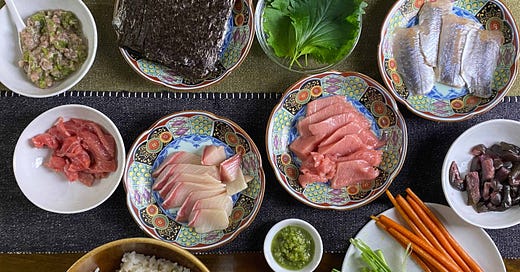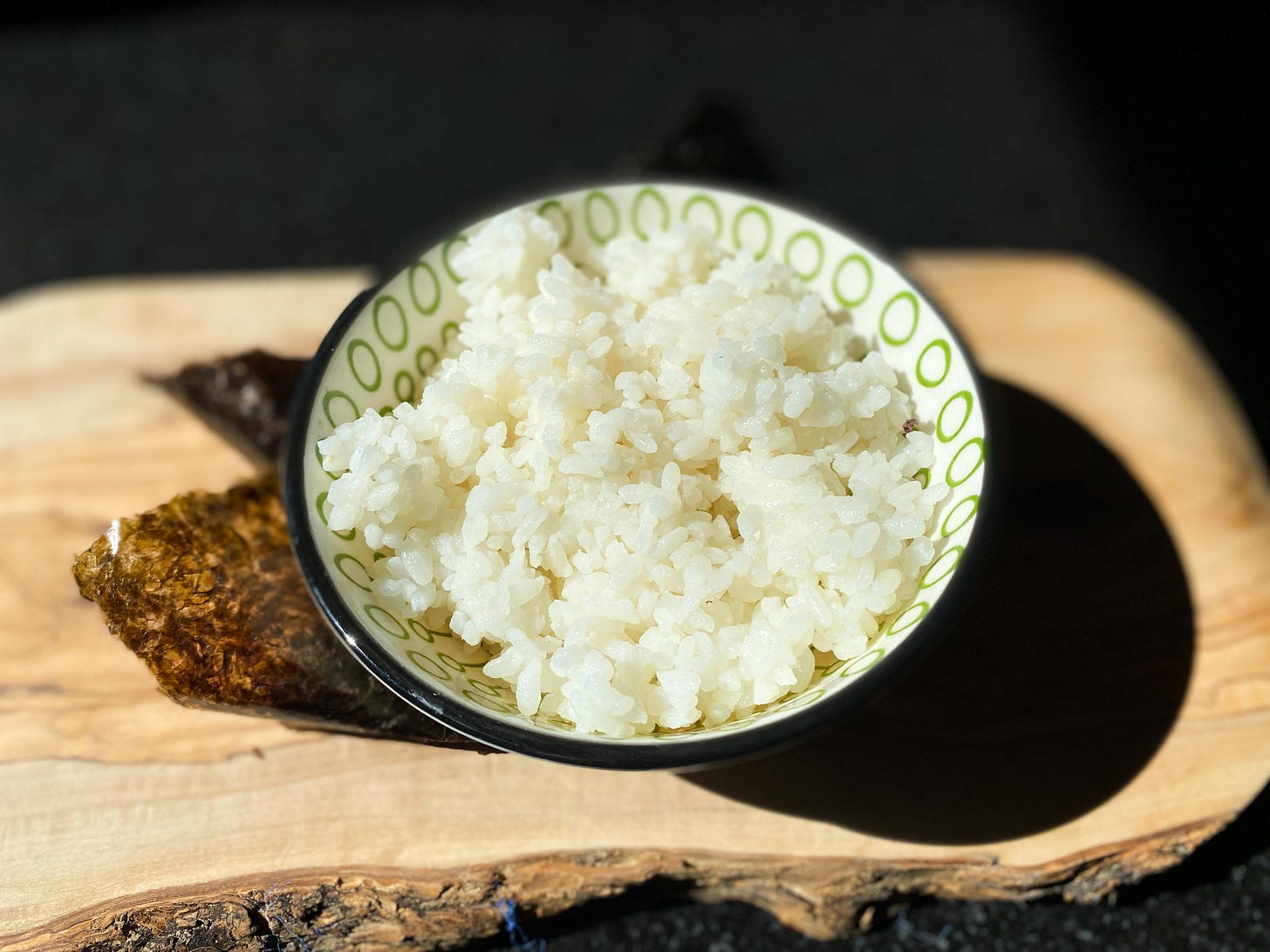
Happy Friday, clever cook!
Inspired by a new Japanese cookbook — Gohan: Memories and Stories from my Family’s Kitchen — Wylie and I put together a hand-roll feast last weekend. We headed up to our local Mitsuwa Marketplace (yep, we’re lucky to have one in North Texas) and picked up beautifully trimmed blocks of hamachi (yellowtail) and farmed bluefin tuna chu-toro — a fatty marbled cut, though not the fattiest. We also got aji, or horse mackerel, and Wylie selected a generous pack of chu-toro kiriotoshi — the leftover pieces from slicing sashimi. Scallions, shiso leaves, ginger, wasabi, assorted Japanese pickles, tofu and sake filled in the gaps.
I already had Japanese artisanal soy sauce on hand, along with plenty of nori (dried seaweed, the wrapper) and high-quality short-grain rice.
The idea behind the hand-roll feast is you slice the fish, prep the accompaniments, cut squares of nori, make and season the rice and lay everything out on the table. Everyone (in this case Wylie and I) grabs a nori square, adds a dollop of rice along with fillings, rolls it into a cone, dips in shoyu and enjoys. It’s a fantastic way to satisfy a sushi craving without spending an arm and a leg. Part of the joy is you can give your rice the proper vinegar tang: Something that’s often lacking in mediocre sushi spots, even though sushi means “vinegar” in Japanese.
Wylie used the chu-toro trimmings to make an excellent negi-toro filling (chopped tuna, sliced scallions, wasabi), and then without thinking much about it, we used Davies’ recipe for sushi rice.
Such delicious fun! It looked a bit different than the spread Davies suggested in her book, but that’s the beauty of this kind of feast — you can customize it. Next time I’ll add daikon sprouts, slices of avocado, batons of Persian cukes and maybe make some kind of marinated firm tofu, for vegan variations.
One cue we did take from Davies’ book was cutting the nori sheets into quarters. At first they seemed too small, but we wound up loving the size — just two or three bites — which allowed for lots of freshness and variety.
The magic ingredient that really made the flavors pop was the shiso: It’s like eating a delicious perfume. I think I included it in every roll. Scallions play very well, too, and if you can get real wasabi, that’s a huge plus. I like Kameya Original, which comes in a plastic tube. (We found it at Mitsuwa; you can buy it online.)
Back to the rice
If there is a rabbit hole to fall into on any given project, I will fall into it — guaranteed. This time it was the rice, or more specifically the sushi vinegar to flavor the rice.
OK, if you know a little bit about sushi, you know that the quality of the rice is hugely important. Making it properly involves rinsing, cooking, fanning, adding sushi vinegar, using proper mixing technique, giving each grain a nice gloss, not breaking the grains, keeping it just warm enough until you serve it. What I had never thought much about before was the flavoring of the sushi vinegar; it’s just rice vinegar, salt and sugar, right?
As I mentioned, we followed Davies’ recipe: She combines 125 ml (1/2 cup) rice vinegar with 3 tablespoons sugar and 1 tablespoon salt, heats just till the sugar and salt are dissolved and removes from heat. She uses that to dress a batch of rice made from 300 g (1 1/2 cups) of rice.
It was fine, but a bit sweet for our taste, and that made me wonder: Is there a standard, accepted ratio of salt to sugar in sushi vinegar?
Loudly and emphatically NO! I looked in every Japanese cookbook I have, and also bought a new sushi book published last year, consulting eight sources in total. I was shocked at the variation in sushi vinegar recipes, and even learned that sugar was not traditional, that many serious sushi chefs use red vinegar (which is a little sweet) instead of rice vinegar and that some use black vinegar as well. Mirin (rice wine) and/or kombu and/or soy sauce are sometimes also included.
Wylie and I (mostly Wylie) painstakingly calculated the vinegar-sugar-salt formulas according to each of the books, and came up with the amount, in each case, needed to dress the rice that you get if you start with 400 grams / 2 cups of raw rice. In each case you combine the ingredients over low heat, stir to dissolve the salt and sugar, and remove from the heat. Do not let it boil.
The vinegar formulas
Here are the books consulted, and the formulas we calculated based on their recipes. In the past, I’ve used and been satisfied with the sushi vinegar recipes from the first two listed:





